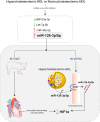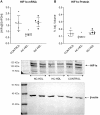High-density lipoprotein remodelled in hypercholesterolaemic blood induce epigenetically driven down-regulation of endothelial HIF-1α expression in a preclinical animal model
- PMID: 31504272
- PMCID: PMC7243281
- DOI: 10.1093/cvr/cvz239
High-density lipoprotein remodelled in hypercholesterolaemic blood induce epigenetically driven down-regulation of endothelial HIF-1α expression in a preclinical animal model
Abstract
Aims: High-density lipoproteins (HDLs) are circulating micelles that transport proteins, lipids, and miRNAs. HDL-transported miRNAs (HDL-miRNAs) have lately received attention but their effects on vascular cells are not fully understood. Additionally, whether cardiovascular risk factors affect HDL-miRNAs levels and miRNA transfer to recipient cells remains equally poorly known. Here, we have investigated the changes induced by hypercholesterolaemia on HDL-miRNA levels and its effect on recipient endothelial cells (ECs).
Methods and results: Pigs were kept on a high-fat diet (HC; n = 10) or a normocholesterolaemic chow (NC; n = 10) for 10 days reaching cholesterol levels of 321.0 (229.7-378.5) mg/dL and 74.0 (62.5-80.2) mg/dL, respectively. HDL particles were isolated, purified, and quantified. HDL-miRNA profiling (n = 149 miRNAs) of HC- and NC-HDLs was performed by multipanel qPCR. Cell cultures of porcine aortic ECs were used to determine whether HDL-miRNAs were delivered to ECs. Potential target genes modulated by miRNAs were identified by bioinformatics and candidate miRNAs were validated by molecular analysis. In vivo effects in the coronary arteries of normocholesterolaemic swine administered HC- or NC-HDLs were analysed. Among the HDL-miRNAs, four were found in different amounts in HC- and NC-HDL (P < 0.05). miR-126-5p and -3p and miR-30b-5p (2.7×, 1.7×, and 1.3×, respectively) were found in higher levels and miR-103a-3p and miR-let-7g-5p (-1.6×, -1.4×, respectively) in lower levels in HC-HDL. miR-126-5p and -3p were transferred from HC-HDL to EC (2.5×; P < 0.05), but not from NC-HDL, by a SRB1-mediated mechanism. Bioinformatics revealed that HIF1α was the miR-126 target gene with the highest predictive value, which was accordingly found to be markedly reduced in HC-HDL-treated ECs and in miR126 mimic transfected ECs. In vivo validation confirmed that HIF1α was diminished in the coronary endothelial layer of NC pigs administered HC-HDL vs. those administered NC-HDL (P < 0.05).
Conclusion: Hypercholesterolaemia induces changes in the miRNA content of HDL enhancing miR126 and its delivery to ECs with the consequent down-regulation of its target gene HIF1α.
Keywords: Dyslipidaemia; Endothelial cells; HDL; Translational research; miRNAs.
© The Author(s) 2019. Published by Oxford University Press on behalf of the European Society of Cardiology.
Figures







Comment in
-
Changes in high-density lipoprotein microRNA might create a lasting memory of high-fat diet.Cardiovasc Res. 2020 Jun 1;116(7):1237-1239. doi: 10.1093/cvr/cvz334. Cardiovasc Res. 2020. PMID: 31873719 No abstract available.
Similar articles
-
HDL (High-Density Lipoprotein) Remodeling and Magnetic Resonance Imaging-Assessed Atherosclerotic Plaque Burden: Study in a Preclinical Experimental Model.Arterioscler Thromb Vasc Biol. 2020 Oct;40(10):2481-2493. doi: 10.1161/ATVBAHA.120.314956. Epub 2020 Aug 27. Arterioscler Thromb Vasc Biol. 2020. PMID: 32847390
-
Detrimental Effect of Hypercholesterolemia on High-Density Lipoprotein Particle Remodeling in Pigs.J Am Coll Cardiol. 2017 Jul 11;70(2):165-178. doi: 10.1016/j.jacc.2017.05.018. J Am Coll Cardiol. 2017. PMID: 28683964
-
Variations in HDL-carried miR-223 and miR-135a concentrations after consumption of dietary trans fat are associated with changes in blood lipid and inflammatory markers in healthy men - an exploratory study.Epigenetics. 2016 Jun 2;11(6):438-48. doi: 10.1080/15592294.2016.1176816. Epub 2016 Apr 21. Epigenetics. 2016. PMID: 27099924 Free PMC article. Clinical Trial.
-
microRNAs and HDL life cycle.Cardiovasc Res. 2014 Aug 1;103(3):414-22. doi: 10.1093/cvr/cvu140. Epub 2014 Jun 3. Cardiovasc Res. 2014. PMID: 24895349 Free PMC article. Review.
-
Lipoprotein carriers of microRNAs.Biochim Biophys Acta. 2016 Dec;1861(12 Pt B):2069-2074. doi: 10.1016/j.bbalip.2016.01.011. Epub 2016 Jan 26. Biochim Biophys Acta. 2016. PMID: 26825691 Free PMC article. Review.
Cited by
-
Cross-Talk between Lipoproteins and Inflammation: The Role of Microvesicles.J Clin Med. 2019 Nov 22;8(12):2059. doi: 10.3390/jcm8122059. J Clin Med. 2019. PMID: 31771128 Free PMC article. Review.
-
Hypercholesterolemia-Induced HDL Dysfunction Can Be Reversed: The Impact of Diet and Statin Treatment in a Preclinical Animal Model.Int J Mol Sci. 2022 Aug 2;23(15):8596. doi: 10.3390/ijms23158596. Int J Mol Sci. 2022. PMID: 35955730 Free PMC article.
-
Methods for the identification and characterization of extracellular vesicles in cardiovascular studies: from exosomes to microvesicles.Cardiovasc Res. 2023 Mar 17;119(1):45-63. doi: 10.1093/cvr/cvac031. Cardiovasc Res. 2023. PMID: 35325061 Free PMC article.
-
Unraveling the Complexity of HDL Remodeling: On the Hunt to Restore HDL Quality.Biomedicines. 2021 Jul 12;9(7):805. doi: 10.3390/biomedicines9070805. Biomedicines. 2021. PMID: 34356869 Free PMC article. Review.
-
HDL-small RNA Export, Transport, and Functional Delivery in Atherosclerosis.Curr Atheroscler Rep. 2021 May 13;23(7):38. doi: 10.1007/s11883-021-00930-7. Curr Atheroscler Rep. 2021. PMID: 33983531 Free PMC article. Review.
References
-
- He L, Hannon GJ.. Erratum: microRNAs: small RNAs with a big role in gene regulation. Nat Rev Genet 2004;5:522–531. - PubMed
-
- Kontush A, Lindahl M, Lhomme M, Calabresi L, Chapman MJ, Davidson WS.. Structure of HDL: particle subclasses and molecular components In Barrett, JE. (ed.). Handbook of Experimental Pharmacology. Switzerland: Springer Nature; 2015. p. 3–51. - PubMed
-
- Badimon L, Vilahur G.. LDL-cholesterol versus HDL-cholesterol in the atherosclerotic plaque: inflammatory resolution versus thrombotic chaos. Ann N Y Acad Sci 2012;1254:18–32. - PubMed
-
- Theilmeier G, Schmidt C, Herrmann J, Keul P, Schäfers M, Herrgott I, Mersmann J, Larmann J, Hermann S, Stypmann J, Schober O, Hildebrand R, Schulz R, Heusch G, Haude M, von Wnuck Lipinski K, Herzog C, Schmitz M, Erbel R, Chun J, Levkau B.. High-density lipoproteins and their constituent, sphingosine-1-phosphate, directly protect the heart against ischemia/reperfusion injury in vivo via the S1P3 lysophospholipid receptor. Circulation 2006;114:1403–1409. - PubMed
-
- Kontush A. HDL-mediated mechanisms of protection in cardiovascular disease. Cardiovasc Res 2014;103:341–349. - PubMed
Publication types
MeSH terms
Substances
LinkOut - more resources
Full Text Sources
Medical

